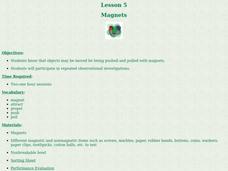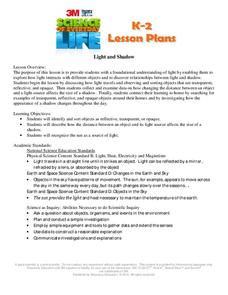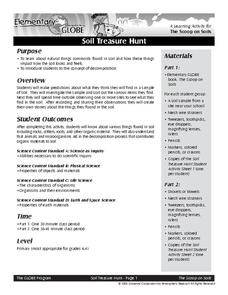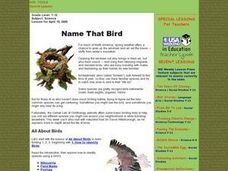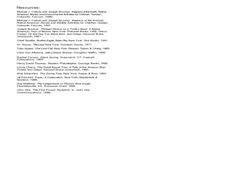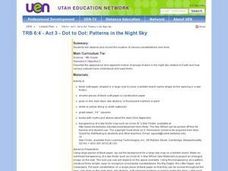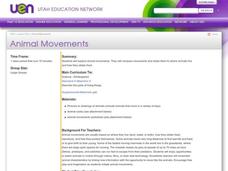Curated OER
Magnets
Students conduct an experiment. In this magnets instructional activity, students review what they know about magnetism, work in groups to determine the magnetism of various objects and discuss their results.
Curated OER
Introduction to Trees and Wood
Students examine samples from various types of trees. In this trees and wood lesson, students review The Giving Tree and complete a KWL chart on trees. Students brainstorm what we get from trees and view wood samples with hand...
Curated OER
Light and shadow
Learners experiment with light and shadow. In this light lesson, students look at the relationship between shadows and light. They experiment with light source, shadow size, transparent objects and reflective objects.
Curated OER
What do Lenses Do?
Students learn to differentiate between different types of lenses. In this lens lesson, students discover how lenses are different and why a specific lens should be used. Students understand how to find the focal point of a lens....
Curated OER
Soil Treasure Hunt
Students explore the concept of soil and decomposition. For this soil and decomposition lesson, students investigate bags of soil. Students then learn how animals and other organisms help in the decomposition process.
Curated OER
Why Do Certain Things Float, While Some Sink?
First graders conduct an experiment. In this density instructional activity, 1st graders work in groups to test 10 different objects to see which ones sink and float. Students discuss why certain objects float and others do not.
Curated OER
Horns or Antlers-You Decide!
Students study the difference between horns and antlers. They identify animals who have each and draw pictures of these animals. They experience samples of actual horns and antlers.
Curated OER
Amphibians Internet Activity
In this amphibians worksheet, students click on the links in the questions about amphibians to find the answers to the questions and then come back and answer the questions. Students answer 10 questions total.
Curated OER
Earth Book
After viewing a teacher-led demonstration on a variety of landforms of the Earth, 1st graders create an Earth book. This nicely-done hands-on lesson has students produce books that describe, in pictures and words, different aspects of...
Curated OER
Creating a Salad Dressing
Learners apply the scientific method to the act of creating a new salad dressing. In this scientific process lesson, students use the process to create personal salad dressing from the materials provided.
Curated OER
Name That Bird
Students view web sites about Birding. They explore how to identify species using a bird's silhouette, posture, size, flight patterns and habitat. They practice birdwatching and notetaking in the outdoors.
Curated OER
Stellaluna
First graders discuss the strategy of asking yourself questions while reading. in this Stellaluna lesson, 1st graders write questions on a chart about the story. Students turn and talk after reading chunks of text. Students see which...
Curated OER
Evolution Lab
Students examine the pattern of natural variation in a society. They examine Darwin's theory of evolution and analyze data. They use computer programs to graphically display the variation in organisms.
Curated OER
Red Tail Ridge Wetland Study Project
Fifth graders use a real life scenario of the wetlands to gather information on creatures of the habitat. For this wetlands lesson, 5th graders research the interdependence of organisms in a healthy habitat. Students collected...
Curated OER
Food Webs in a Pond
Students explore food chains and food webs in a pond and identify common creatures found in ponds. They look for tadpoles, fish, mites and other creatures in a pond during a field trip for first hand research.
Curated OER
How Trashy Are You?
Students determine the amount of trash a teenager produces. In this environmental lesson plan, students use a garbage bag to collect trash during a twenty-four hour period. Students weigh their bags at the end of the twenty-four hours.
Curated OER
Sound
Students identify and explain these vocabulary words: vibration, volume, pitch, particles, tuning forks, waves and matter. They explain that sound travels through gas, liquid and solid. They be
Curated OER
Galactic Inquiry
Students view NASA images of galaxies and develop a galaxy classification scheme. They compare and contrast their classification scheme with that developed by Edwin Hubble. They recognize that galaxies are collections of billions of stars.
Curated OER
Dot to Dot: Patterns in the Night Sky
Sixth graders are introduced to several major constellations and locate them in the night sky. They graph the constellations on grid paper and work in groups to research common myths and stories associated with specific constellations.
Curated OER
Forces and Motion Scavenger Hunt
Students determine how force on an object affects its movement. In this force and motion lesson, students take digital pictures of objects in the school setting that are pushed and pulled. They develop a presentation using the digital...
Curated OER
Why Do Some Birds Have Two Homes When We Have One?
Sixth graders study migratory birds in the temperate forest and the tropical rainforest. In this migratory birds lesson, 6th graders participate in different activities that explain patterns of migration, research patterns of...
Curated OER
Switches
In this switches worksheet, students solve 18 problems about types of switches, circuits, the voltage of the switches, the contact status and the number of poles and throws in switches.
Curated OER
Sports Activity Stations
Fourth graders observe and understand forces applied to an object and the change in speed or direction of the object. In this forces lesson, 4th graders divide into groups and play at various sports stations. Students mark push or pull...
Curated OER
Animal Movements
Students will explore animal movements. They will compare movements and relate them to where animals live and how they obtain food.
